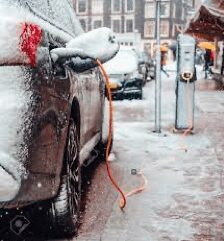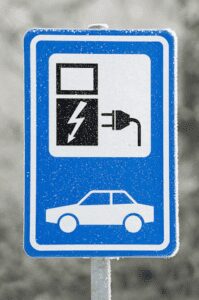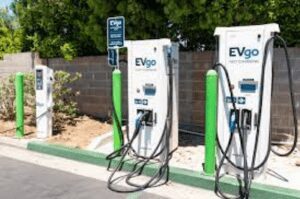Issue 2 | December 2021 | It’s Electric

By Josalyn Bonney
 The cold temperatures of winter are a notoriously fickle time for car batteries. Pair that with blasting heat, defrosters and the radio for background noise, are electric cars really up to the task? As an electric car owner myself, battery life for long trips is a common concern for me as well as interested or new electric vehicle (EV) owners.
The cold temperatures of winter are a notoriously fickle time for car batteries. Pair that with blasting heat, defrosters and the radio for background noise, are electric cars really up to the task? As an electric car owner myself, battery life for long trips is a common concern for me as well as interested or new electric vehicle (EV) owners.
According to a New York Times article, charging infrastructure is on the rise. While many cars can already go 200-plus miles, some (such as the Nissan Leaf 2018 that I own) need an extra boost for longer distances. To close this discrepancy, companies such as EVgo are building hundreds of chargers that can give the average car 100 miles in 20 to 30 minutes. Last year, I took my very first road trip from Annapolis to Williamsburg. While there were some unforeseen setbacks, I was able to make it there and back in one piece–a test that earned a passing grade.
To take a more direct look at how cold affects electric cars,  a piece from InsideHook has the answer from Consumer Reports: “It’s important to note that EV batteries lose range not because of how the cold weather affects the physical battery but because of the added power demands. . .” This means that range reductions happen because of the miscellaneous outputs rather than cold directly affecting the battery itself, resulting in a loss of about 20% fewer miles on average. What this boils down to is that, with the convenience of an at-home charger, you could still get from point A to point B without serious incident.
a piece from InsideHook has the answer from Consumer Reports: “It’s important to note that EV batteries lose range not because of how the cold weather affects the physical battery but because of the added power demands. . .” This means that range reductions happen because of the miscellaneous outputs rather than cold directly affecting the battery itself, resulting in a loss of about 20% fewer miles on average. What this boils down to is that, with the convenience of an at-home charger, you could still get from point A to point B without serious incident.
While there are several hindrances to winter usage, such as limits to regenerative braking and charging, there are workarounds. Wired suggests keeping the battery from getting too low by maintaining at least a 20% charge and, when you plug in, take advantage of the extra charge to warm up the car. Some tips from Green Car Reports include preconditioning the battery before the start of the trip (some EVs such as Teslas have an app that lets you do this), using the Eco-mode setting which lowers the energy usage, and wearing a coat to save on heat.  Although this last point may seem least preferred (who would want to wear a coat instead of sitting in a toasty car cabin?), this is one of my personal preferred methods of battery saving. I find that in the Nissan Leaf, almost thirty miles goes to warming the car when I put the heat on. Even after owning an electric car for over a year with no major mishaps, I’m about as paranoid as any EV driver about battery range; so I choose to drive with a coat even in mild winter temperatures.
Although this last point may seem least preferred (who would want to wear a coat instead of sitting in a toasty car cabin?), this is one of my personal preferred methods of battery saving. I find that in the Nissan Leaf, almost thirty miles goes to warming the car when I put the heat on. Even after owning an electric car for over a year with no major mishaps, I’m about as paranoid as any EV driver about battery range; so I choose to drive with a coat even in mild winter temperatures.
All in all, I would say that electric cars are up to the task of winter driving and their performance is only being improved upon. While the extra planning to ensure battery efficiency might be a hassle that gas cars don’t have, the overall benefits outweigh the costs. Imagine never having to pay for gas again!


Well written article and I appreciate the editor’s opinion and personal experience. Just as some gas powered drivers are not comfortable allowing their fuel to go below a 1/4 tank, other drivers are more risk tolerant. I suspect the same can be said for EV drivers and their outputs affecting battery thresholds. We have been driving an EV for 3+ years, including long range trips, and generally don’t curtail the outputs unless we absolutely need to.
All in all, the tips to conserve battery are welcomed. Thanks!